Research Report on SAP S/4HANA
VerifiedAdded on 2023/06/03
|14
|4683
|156
AI Summary
The report analyzes SAP S/4HANA, its benefits, features, and challenges faced during implementation. It also highlights the differences between SAP S/4HANA and ERP FICO. The report includes a case study of three companies and discusses the advantages of SAP S/4HANA in financial planning, accounting, and risk management.
Contribute Materials
Your contribution can guide someone’s learning journey. Share your
documents today.
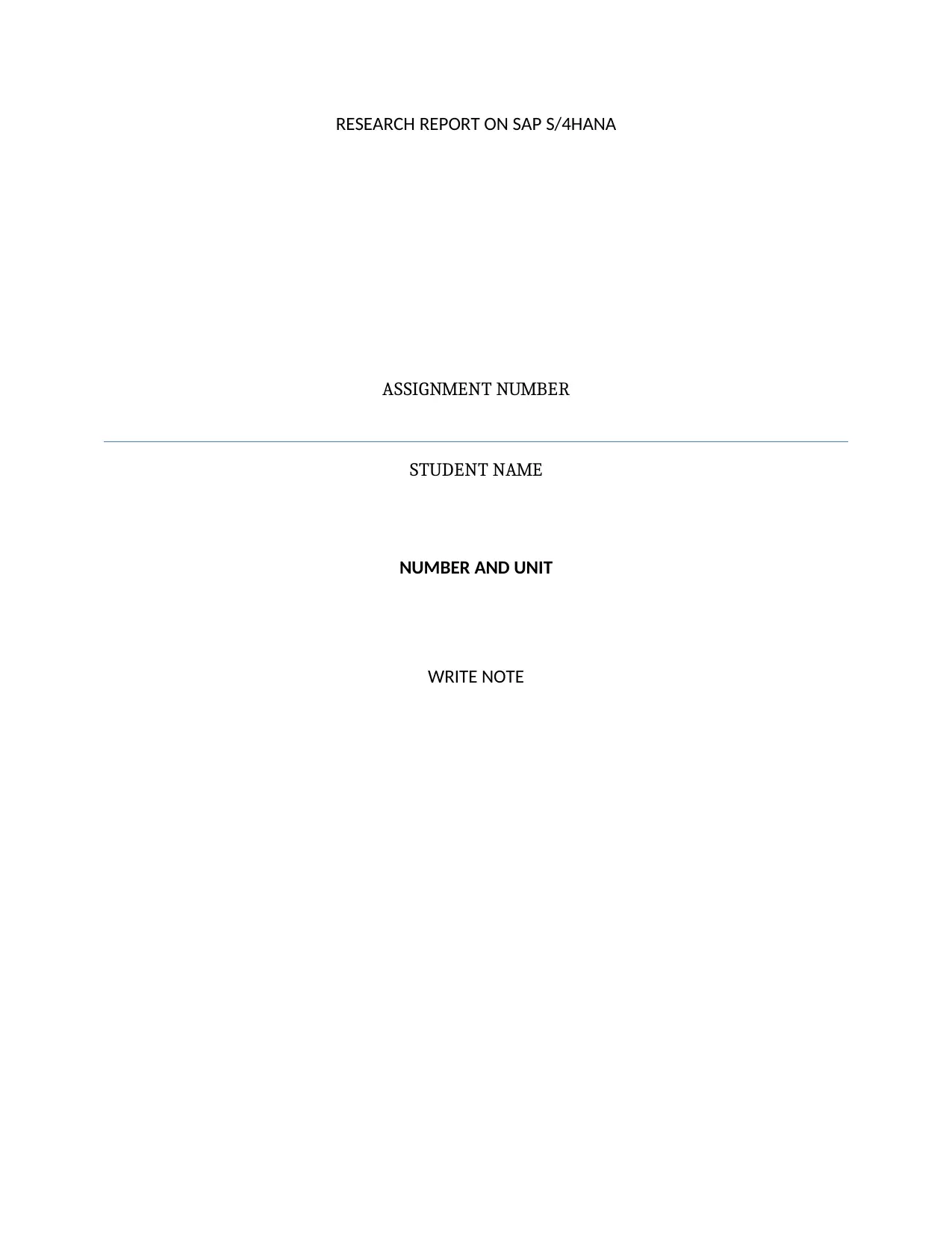
RESEARCH REPORT ON SAP S/4HANA
ASSIGNMENT NUMBER
STUDENT NAME
NUMBER AND UNIT
WRITE NOTE
ASSIGNMENT NUMBER
STUDENT NAME
NUMBER AND UNIT
WRITE NOTE
Secure Best Marks with AI Grader
Need help grading? Try our AI Grader for instant feedback on your assignments.
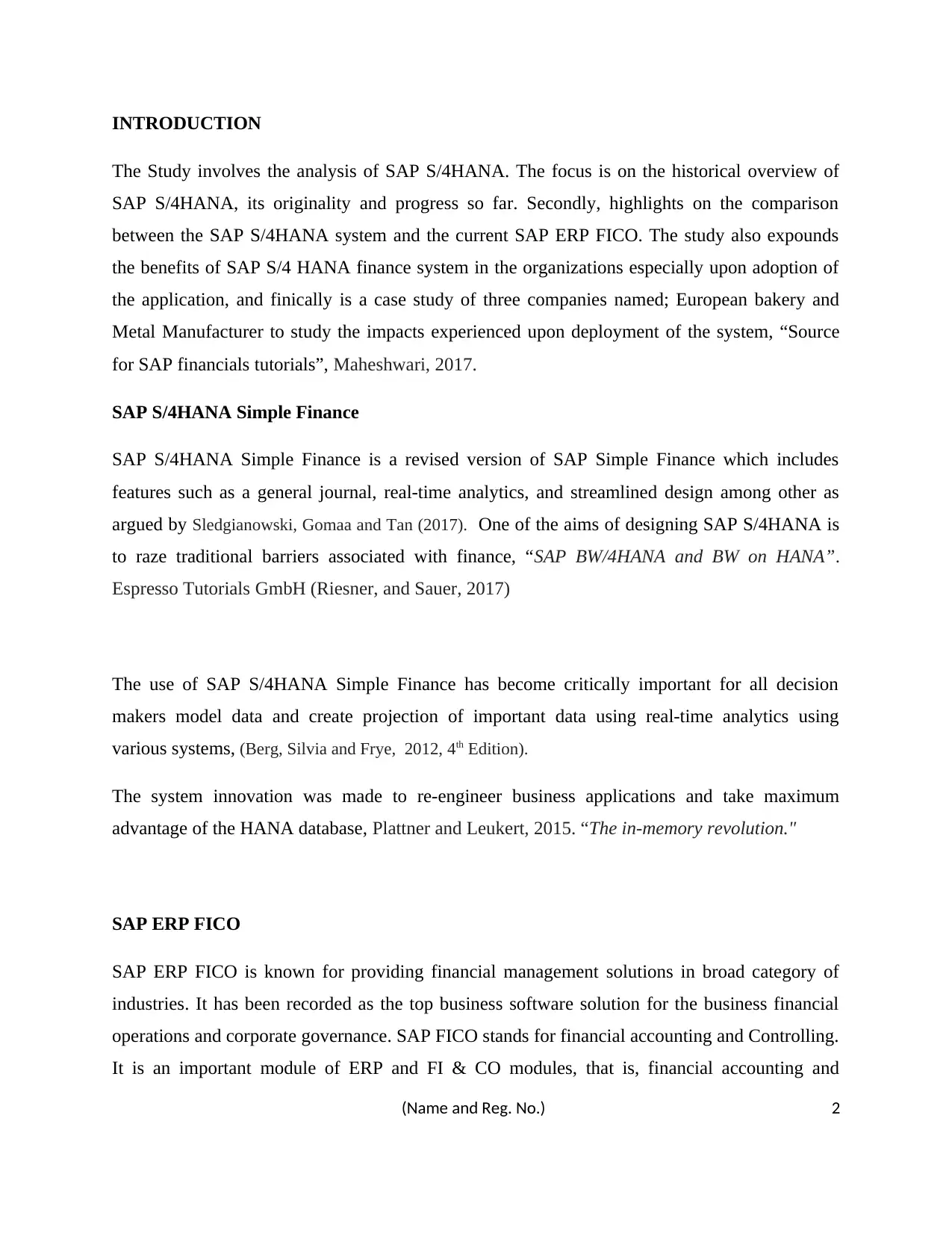
INTRODUCTION
The Study involves the analysis of SAP S/4HANA. The focus is on the historical overview of
SAP S/4HANA, its originality and progress so far. Secondly, highlights on the comparison
between the SAP S/4HANA system and the current SAP ERP FICO. The study also expounds
the benefits of SAP S/4 HANA finance system in the organizations especially upon adoption of
the application, and finically is a case study of three companies named; European bakery and
Metal Manufacturer to study the impacts experienced upon deployment of the system, “Source
for SAP financials tutorials”, Maheshwari, 2017.
SAP S/4HANA Simple Finance
SAP S/4HANA Simple Finance is a revised version of SAP Simple Finance which includes
features such as a general journal, real-time analytics, and streamlined design among other as
argued by Sledgianowski, Gomaa and Tan (2017). One of the aims of designing SAP S/4HANA is
to raze traditional barriers associated with finance, “SAP BW/4HANA and BW on HANA”.
Espresso Tutorials GmbH (Riesner, and Sauer, 2017)
The use of SAP S/4HANA Simple Finance has become critically important for all decision
makers model data and create projection of important data using real-time analytics using
various systems, (Berg, Silvia and Frye, 2012, 4th Edition).
The system innovation was made to re-engineer business applications and take maximum
advantage of the HANA database, Plattner and Leukert, 2015. “The in-memory revolution."
SAP ERP FICO
SAP ERP FICO is known for providing financial management solutions in broad category of
industries. It has been recorded as the top business software solution for the business financial
operations and corporate governance. SAP FICO stands for financial accounting and Controlling.
It is an important module of ERP and FI & CO modules, that is, financial accounting and
(Name and Reg. No.) 2
The Study involves the analysis of SAP S/4HANA. The focus is on the historical overview of
SAP S/4HANA, its originality and progress so far. Secondly, highlights on the comparison
between the SAP S/4HANA system and the current SAP ERP FICO. The study also expounds
the benefits of SAP S/4 HANA finance system in the organizations especially upon adoption of
the application, and finically is a case study of three companies named; European bakery and
Metal Manufacturer to study the impacts experienced upon deployment of the system, “Source
for SAP financials tutorials”, Maheshwari, 2017.
SAP S/4HANA Simple Finance
SAP S/4HANA Simple Finance is a revised version of SAP Simple Finance which includes
features such as a general journal, real-time analytics, and streamlined design among other as
argued by Sledgianowski, Gomaa and Tan (2017). One of the aims of designing SAP S/4HANA is
to raze traditional barriers associated with finance, “SAP BW/4HANA and BW on HANA”.
Espresso Tutorials GmbH (Riesner, and Sauer, 2017)
The use of SAP S/4HANA Simple Finance has become critically important for all decision
makers model data and create projection of important data using real-time analytics using
various systems, (Berg, Silvia and Frye, 2012, 4th Edition).
The system innovation was made to re-engineer business applications and take maximum
advantage of the HANA database, Plattner and Leukert, 2015. “The in-memory revolution."
SAP ERP FICO
SAP ERP FICO is known for providing financial management solutions in broad category of
industries. It has been recorded as the top business software solution for the business financial
operations and corporate governance. SAP FICO stands for financial accounting and Controlling.
It is an important module of ERP and FI & CO modules, that is, financial accounting and
(Name and Reg. No.) 2
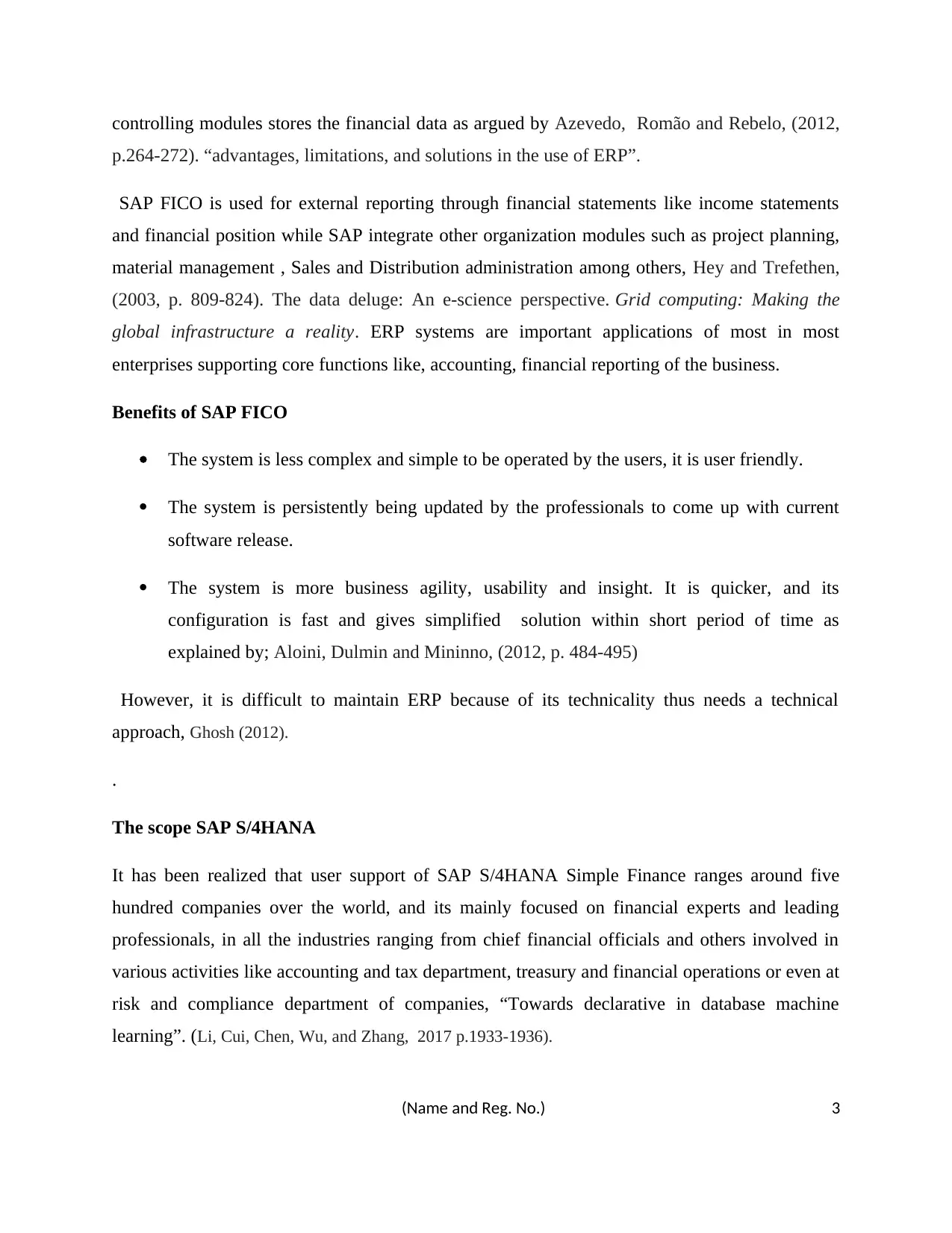
controlling modules stores the financial data as argued by Azevedo, Romão and Rebelo, (2012,
p.264-272). “advantages, limitations, and solutions in the use of ERP”.
SAP FICO is used for external reporting through financial statements like income statements
and financial position while SAP integrate other organization modules such as project planning,
material management , Sales and Distribution administration among others, Hey and Trefethen,
(2003, p. 809-824). The data deluge: An e‐science perspective. Grid computing: Making the
global infrastructure a reality. ERP systems are important applications of most in most
enterprises supporting core functions like, accounting, financial reporting of the business.
Benefits of SAP FICO
The system is less complex and simple to be operated by the users, it is user friendly.
The system is persistently being updated by the professionals to come up with current
software release.
The system is more business agility, usability and insight. It is quicker, and its
configuration is fast and gives simplified solution within short period of time as
explained by; Aloini, Dulmin and Mininno, (2012, p. 484-495)
However, it is difficult to maintain ERP because of its technicality thus needs a technical
approach, Ghosh (2012).
.
The scope SAP S/4HANA
It has been realized that user support of SAP S/4HANA Simple Finance ranges around five
hundred companies over the world, and its mainly focused on financial experts and leading
professionals, in all the industries ranging from chief financial officials and others involved in
various activities like accounting and tax department, treasury and financial operations or even at
risk and compliance department of companies, “Towards declarative in database machine
learning”. (Li, Cui, Chen, Wu, and Zhang, 2017 p.1933-1936).
(Name and Reg. No.) 3
p.264-272). “advantages, limitations, and solutions in the use of ERP”.
SAP FICO is used for external reporting through financial statements like income statements
and financial position while SAP integrate other organization modules such as project planning,
material management , Sales and Distribution administration among others, Hey and Trefethen,
(2003, p. 809-824). The data deluge: An e‐science perspective. Grid computing: Making the
global infrastructure a reality. ERP systems are important applications of most in most
enterprises supporting core functions like, accounting, financial reporting of the business.
Benefits of SAP FICO
The system is less complex and simple to be operated by the users, it is user friendly.
The system is persistently being updated by the professionals to come up with current
software release.
The system is more business agility, usability and insight. It is quicker, and its
configuration is fast and gives simplified solution within short period of time as
explained by; Aloini, Dulmin and Mininno, (2012, p. 484-495)
However, it is difficult to maintain ERP because of its technicality thus needs a technical
approach, Ghosh (2012).
.
The scope SAP S/4HANA
It has been realized that user support of SAP S/4HANA Simple Finance ranges around five
hundred companies over the world, and its mainly focused on financial experts and leading
professionals, in all the industries ranging from chief financial officials and others involved in
various activities like accounting and tax department, treasury and financial operations or even at
risk and compliance department of companies, “Towards declarative in database machine
learning”. (Li, Cui, Chen, Wu, and Zhang, 2017 p.1933-1936).
(Name and Reg. No.) 3
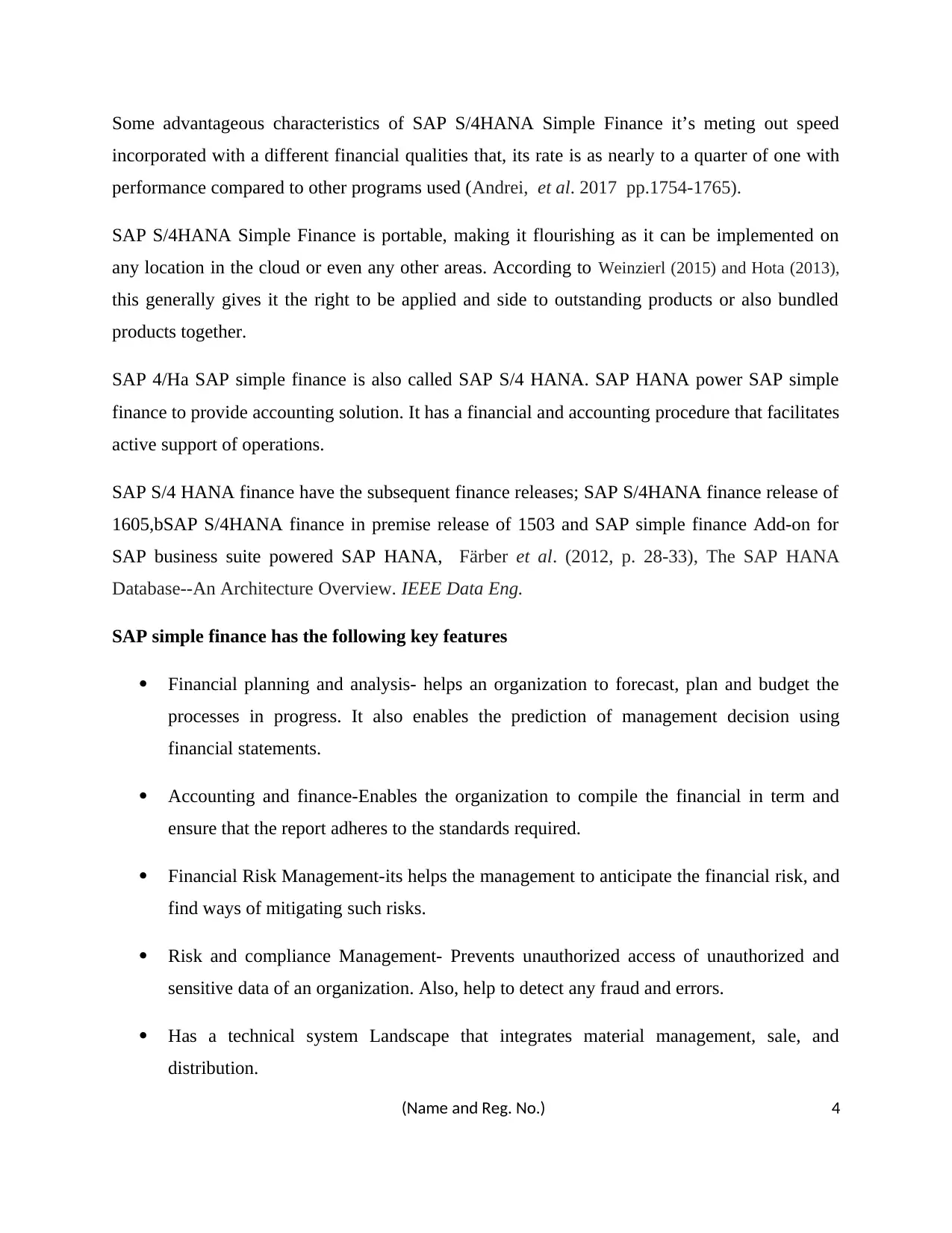
Some advantageous characteristics of SAP S/4HANA Simple Finance it’s meting out speed
incorporated with a different financial qualities that, its rate is as nearly to a quarter of one with
performance compared to other programs used (Andrei, et al. 2017 pp.1754-1765).
SAP S/4HANA Simple Finance is portable, making it flourishing as it can be implemented on
any location in the cloud or even any other areas. According to Weinzierl (2015) and Hota (2013),
this generally gives it the right to be applied and side to outstanding products or also bundled
products together.
SAP 4/Ha SAP simple finance is also called SAP S/4 HANA. SAP HANA power SAP simple
finance to provide accounting solution. It has a financial and accounting procedure that facilitates
active support of operations.
SAP S/4 HANA finance have the subsequent finance releases; SAP S/4HANA finance release of
1605,bSAP S/4HANA finance in premise release of 1503 and SAP simple finance Add-on for
SAP business suite powered SAP HANA, Färber et al. (2012, p. 28-33), The SAP HANA
Database--An Architecture Overview. IEEE Data Eng.
SAP simple finance has the following key features
Financial planning and analysis- helps an organization to forecast, plan and budget the
processes in progress. It also enables the prediction of management decision using
financial statements.
Accounting and finance-Enables the organization to compile the financial in term and
ensure that the report adheres to the standards required.
Financial Risk Management-its helps the management to anticipate the financial risk, and
find ways of mitigating such risks.
Risk and compliance Management- Prevents unauthorized access of unauthorized and
sensitive data of an organization. Also, help to detect any fraud and errors.
Has a technical system Landscape that integrates material management, sale, and
distribution.
(Name and Reg. No.) 4
incorporated with a different financial qualities that, its rate is as nearly to a quarter of one with
performance compared to other programs used (Andrei, et al. 2017 pp.1754-1765).
SAP S/4HANA Simple Finance is portable, making it flourishing as it can be implemented on
any location in the cloud or even any other areas. According to Weinzierl (2015) and Hota (2013),
this generally gives it the right to be applied and side to outstanding products or also bundled
products together.
SAP 4/Ha SAP simple finance is also called SAP S/4 HANA. SAP HANA power SAP simple
finance to provide accounting solution. It has a financial and accounting procedure that facilitates
active support of operations.
SAP S/4 HANA finance have the subsequent finance releases; SAP S/4HANA finance release of
1605,bSAP S/4HANA finance in premise release of 1503 and SAP simple finance Add-on for
SAP business suite powered SAP HANA, Färber et al. (2012, p. 28-33), The SAP HANA
Database--An Architecture Overview. IEEE Data Eng.
SAP simple finance has the following key features
Financial planning and analysis- helps an organization to forecast, plan and budget the
processes in progress. It also enables the prediction of management decision using
financial statements.
Accounting and finance-Enables the organization to compile the financial in term and
ensure that the report adheres to the standards required.
Financial Risk Management-its helps the management to anticipate the financial risk, and
find ways of mitigating such risks.
Risk and compliance Management- Prevents unauthorized access of unauthorized and
sensitive data of an organization. Also, help to detect any fraud and errors.
Has a technical system Landscape that integrates material management, sale, and
distribution.
(Name and Reg. No.) 4
Secure Best Marks with AI Grader
Need help grading? Try our AI Grader for instant feedback on your assignments.
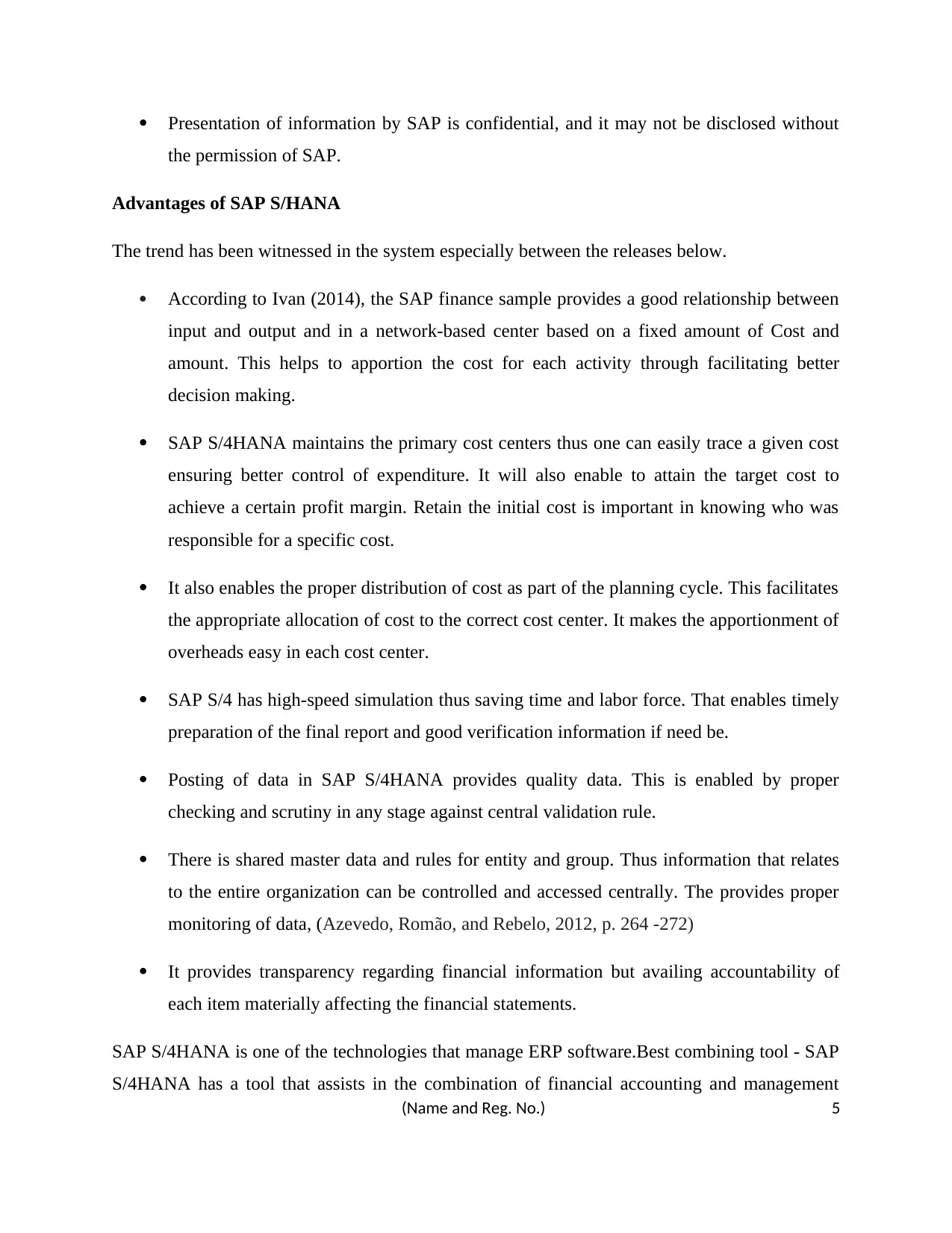
Presentation of information by SAP is confidential, and it may not be disclosed without
the permission of SAP.
Advantages of SAP S/HANA
The trend has been witnessed in the system especially between the releases below.
According to Ivan (2014), the SAP finance sample provides a good relationship between
input and output and in a network-based center based on a fixed amount of Cost and
amount. This helps to apportion the cost for each activity through facilitating better
decision making.
SAP S/4HANA maintains the primary cost centers thus one can easily trace a given cost
ensuring better control of expenditure. It will also enable to attain the target cost to
achieve a certain profit margin. Retain the initial cost is important in knowing who was
responsible for a specific cost.
It also enables the proper distribution of cost as part of the planning cycle. This facilitates
the appropriate allocation of cost to the correct cost center. It makes the apportionment of
overheads easy in each cost center.
SAP S/4 has high-speed simulation thus saving time and labor force. That enables timely
preparation of the final report and good verification information if need be.
Posting of data in SAP S/4HANA provides quality data. This is enabled by proper
checking and scrutiny in any stage against central validation rule.
There is shared master data and rules for entity and group. Thus information that relates
to the entire organization can be controlled and accessed centrally. The provides proper
monitoring of data, (Azevedo, Romão, and Rebelo, 2012, p. 264 -272)
It provides transparency regarding financial information but availing accountability of
each item materially affecting the financial statements.
SAP S/4HANA is one of the technologies that manage ERP software.Best combining tool - SAP
S/4HANA has a tool that assists in the combination of financial accounting and management
(Name and Reg. No.) 5
the permission of SAP.
Advantages of SAP S/HANA
The trend has been witnessed in the system especially between the releases below.
According to Ivan (2014), the SAP finance sample provides a good relationship between
input and output and in a network-based center based on a fixed amount of Cost and
amount. This helps to apportion the cost for each activity through facilitating better
decision making.
SAP S/4HANA maintains the primary cost centers thus one can easily trace a given cost
ensuring better control of expenditure. It will also enable to attain the target cost to
achieve a certain profit margin. Retain the initial cost is important in knowing who was
responsible for a specific cost.
It also enables the proper distribution of cost as part of the planning cycle. This facilitates
the appropriate allocation of cost to the correct cost center. It makes the apportionment of
overheads easy in each cost center.
SAP S/4 has high-speed simulation thus saving time and labor force. That enables timely
preparation of the final report and good verification information if need be.
Posting of data in SAP S/4HANA provides quality data. This is enabled by proper
checking and scrutiny in any stage against central validation rule.
There is shared master data and rules for entity and group. Thus information that relates
to the entire organization can be controlled and accessed centrally. The provides proper
monitoring of data, (Azevedo, Romão, and Rebelo, 2012, p. 264 -272)
It provides transparency regarding financial information but availing accountability of
each item materially affecting the financial statements.
SAP S/4HANA is one of the technologies that manage ERP software.Best combining tool - SAP
S/4HANA has a tool that assists in the combination of financial accounting and management
(Name and Reg. No.) 5
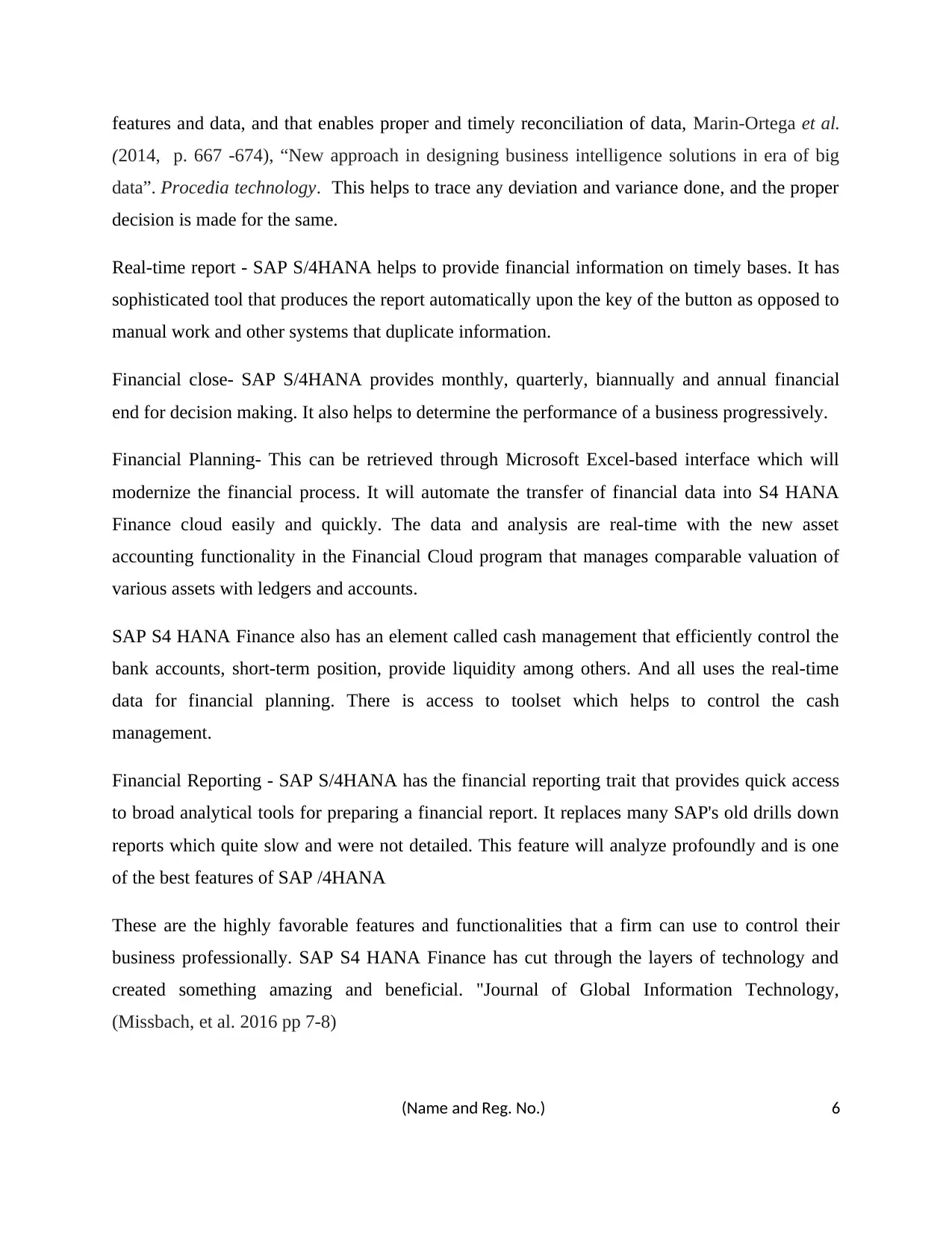
features and data, and that enables proper and timely reconciliation of data, Marin-Ortega et al.
(2014, p. 667 -674), “New approach in designing business intelligence solutions in era of big
data”. Procedia technology. This helps to trace any deviation and variance done, and the proper
decision is made for the same.
Real-time report - SAP S/4HANA helps to provide financial information on timely bases. It has
sophisticated tool that produces the report automatically upon the key of the button as opposed to
manual work and other systems that duplicate information.
Financial close- SAP S/4HANA provides monthly, quarterly, biannually and annual financial
end for decision making. It also helps to determine the performance of a business progressively.
Financial Planning- This can be retrieved through Microsoft Excel-based interface which will
modernize the financial process. It will automate the transfer of financial data into S4 HANA
Finance cloud easily and quickly. The data and analysis are real-time with the new asset
accounting functionality in the Financial Cloud program that manages comparable valuation of
various assets with ledgers and accounts.
SAP S4 HANA Finance also has an element called cash management that efficiently control the
bank accounts, short-term position, provide liquidity among others. And all uses the real-time
data for financial planning. There is access to toolset which helps to control the cash
management.
Financial Reporting - SAP S/4HANA has the financial reporting trait that provides quick access
to broad analytical tools for preparing a financial report. It replaces many SAP's old drills down
reports which quite slow and were not detailed. This feature will analyze profoundly and is one
of the best features of SAP /4HANA
These are the highly favorable features and functionalities that a firm can use to control their
business professionally. SAP S4 HANA Finance has cut through the layers of technology and
created something amazing and beneficial. "Journal of Global Information Technology,
(Missbach, et al. 2016 pp 7-8)
(Name and Reg. No.) 6
(2014, p. 667 -674), “New approach in designing business intelligence solutions in era of big
data”. Procedia technology. This helps to trace any deviation and variance done, and the proper
decision is made for the same.
Real-time report - SAP S/4HANA helps to provide financial information on timely bases. It has
sophisticated tool that produces the report automatically upon the key of the button as opposed to
manual work and other systems that duplicate information.
Financial close- SAP S/4HANA provides monthly, quarterly, biannually and annual financial
end for decision making. It also helps to determine the performance of a business progressively.
Financial Planning- This can be retrieved through Microsoft Excel-based interface which will
modernize the financial process. It will automate the transfer of financial data into S4 HANA
Finance cloud easily and quickly. The data and analysis are real-time with the new asset
accounting functionality in the Financial Cloud program that manages comparable valuation of
various assets with ledgers and accounts.
SAP S4 HANA Finance also has an element called cash management that efficiently control the
bank accounts, short-term position, provide liquidity among others. And all uses the real-time
data for financial planning. There is access to toolset which helps to control the cash
management.
Financial Reporting - SAP S/4HANA has the financial reporting trait that provides quick access
to broad analytical tools for preparing a financial report. It replaces many SAP's old drills down
reports which quite slow and were not detailed. This feature will analyze profoundly and is one
of the best features of SAP /4HANA
These are the highly favorable features and functionalities that a firm can use to control their
business professionally. SAP S4 HANA Finance has cut through the layers of technology and
created something amazing and beneficial. "Journal of Global Information Technology,
(Missbach, et al. 2016 pp 7-8)
(Name and Reg. No.) 6
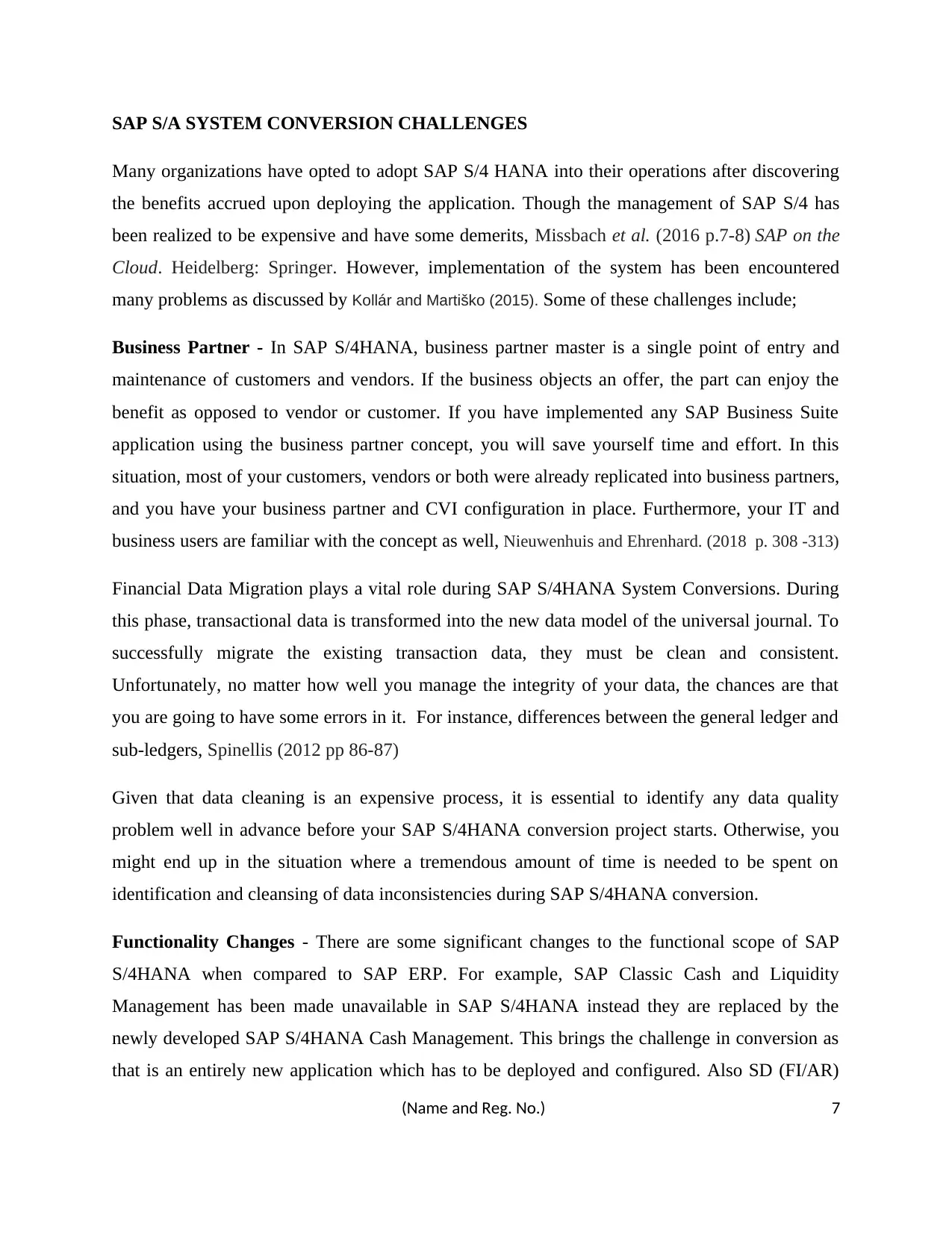
SAP S/A SYSTEM CONVERSION CHALLENGES
Many organizations have opted to adopt SAP S/4 HANA into their operations after discovering
the benefits accrued upon deploying the application. Though the management of SAP S/4 has
been realized to be expensive and have some demerits, Missbach et al. (2016 p.7-8) SAP on the
Cloud. Heidelberg: Springer. However, implementation of the system has been encountered
many problems as discussed by Kollár and Martiško (2015). Some of these challenges include;
Business Partner - In SAP S/4HANA, business partner master is a single point of entry and
maintenance of customers and vendors. If the business objects an offer, the part can enjoy the
benefit as opposed to vendor or customer. If you have implemented any SAP Business Suite
application using the business partner concept, you will save yourself time and effort. In this
situation, most of your customers, vendors or both were already replicated into business partners,
and you have your business partner and CVI configuration in place. Furthermore, your IT and
business users are familiar with the concept as well, Nieuwenhuis and Ehrenhard. (2018 p. 308 -313)
Financial Data Migration plays a vital role during SAP S/4HANA System Conversions. During
this phase, transactional data is transformed into the new data model of the universal journal. To
successfully migrate the existing transaction data, they must be clean and consistent.
Unfortunately, no matter how well you manage the integrity of your data, the chances are that
you are going to have some errors in it. For instance, differences between the general ledger and
sub-ledgers, Spinellis (2012 pp 86-87)
Given that data cleaning is an expensive process, it is essential to identify any data quality
problem well in advance before your SAP S/4HANA conversion project starts. Otherwise, you
might end up in the situation where a tremendous amount of time is needed to be spent on
identification and cleansing of data inconsistencies during SAP S/4HANA conversion.
Functionality Changes - There are some significant changes to the functional scope of SAP
S/4HANA when compared to SAP ERP. For example, SAP Classic Cash and Liquidity
Management has been made unavailable in SAP S/4HANA instead they are replaced by the
newly developed SAP S/4HANA Cash Management. This brings the challenge in conversion as
that is an entirely new application which has to be deployed and configured. Also SD (FI/AR)
(Name and Reg. No.) 7
Many organizations have opted to adopt SAP S/4 HANA into their operations after discovering
the benefits accrued upon deploying the application. Though the management of SAP S/4 has
been realized to be expensive and have some demerits, Missbach et al. (2016 p.7-8) SAP on the
Cloud. Heidelberg: Springer. However, implementation of the system has been encountered
many problems as discussed by Kollár and Martiško (2015). Some of these challenges include;
Business Partner - In SAP S/4HANA, business partner master is a single point of entry and
maintenance of customers and vendors. If the business objects an offer, the part can enjoy the
benefit as opposed to vendor or customer. If you have implemented any SAP Business Suite
application using the business partner concept, you will save yourself time and effort. In this
situation, most of your customers, vendors or both were already replicated into business partners,
and you have your business partner and CVI configuration in place. Furthermore, your IT and
business users are familiar with the concept as well, Nieuwenhuis and Ehrenhard. (2018 p. 308 -313)
Financial Data Migration plays a vital role during SAP S/4HANA System Conversions. During
this phase, transactional data is transformed into the new data model of the universal journal. To
successfully migrate the existing transaction data, they must be clean and consistent.
Unfortunately, no matter how well you manage the integrity of your data, the chances are that
you are going to have some errors in it. For instance, differences between the general ledger and
sub-ledgers, Spinellis (2012 pp 86-87)
Given that data cleaning is an expensive process, it is essential to identify any data quality
problem well in advance before your SAP S/4HANA conversion project starts. Otherwise, you
might end up in the situation where a tremendous amount of time is needed to be spent on
identification and cleansing of data inconsistencies during SAP S/4HANA conversion.
Functionality Changes - There are some significant changes to the functional scope of SAP
S/4HANA when compared to SAP ERP. For example, SAP Classic Cash and Liquidity
Management has been made unavailable in SAP S/4HANA instead they are replaced by the
newly developed SAP S/4HANA Cash Management. This brings the challenge in conversion as
that is an entirely new application which has to be deployed and configured. Also SD (FI/AR)
(Name and Reg. No.) 7
Paraphrase This Document
Need a fresh take? Get an instant paraphrase of this document with our AI Paraphraser
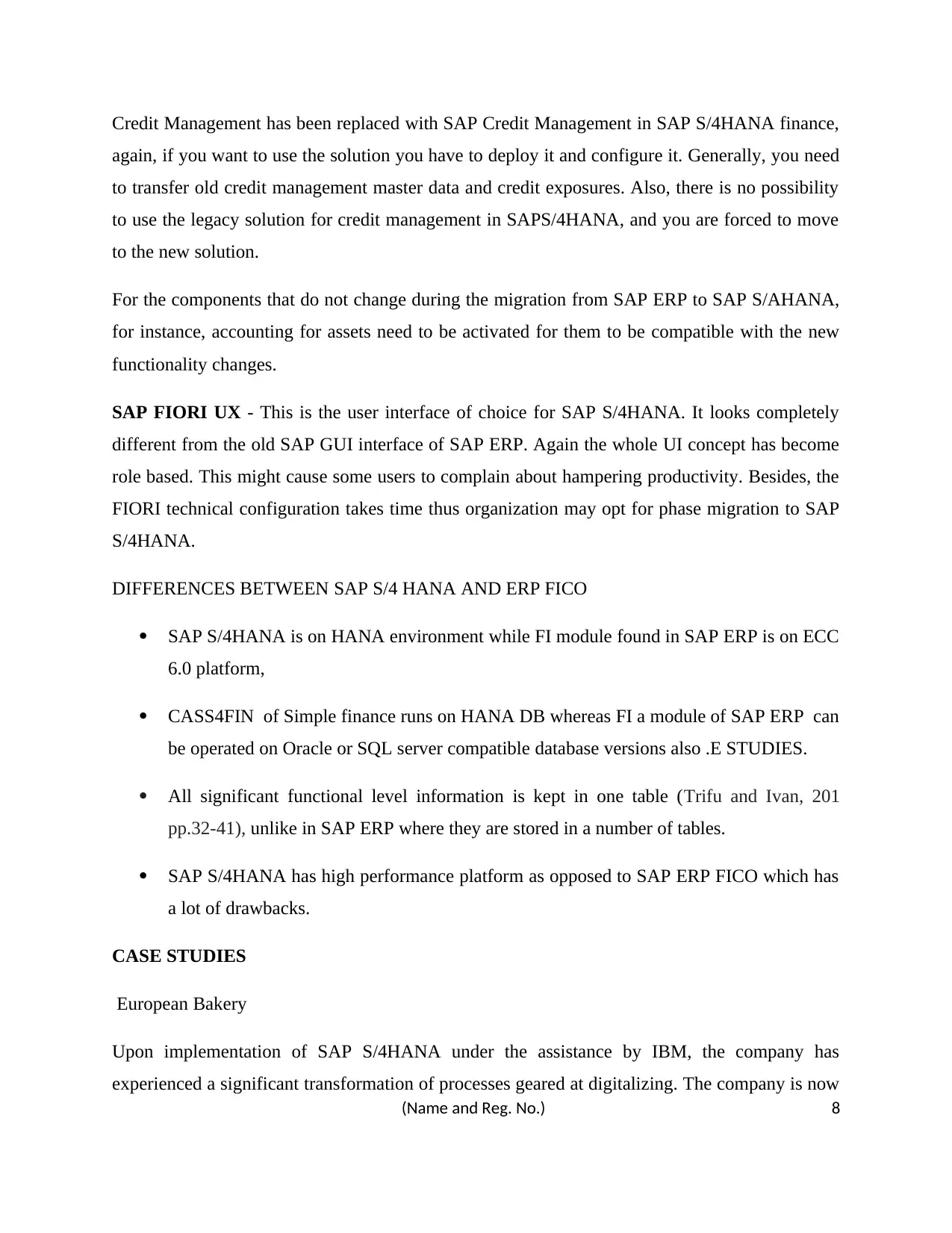
Credit Management has been replaced with SAP Credit Management in SAP S/4HANA finance,
again, if you want to use the solution you have to deploy it and configure it. Generally, you need
to transfer old credit management master data and credit exposures. Also, there is no possibility
to use the legacy solution for credit management in SAPS/4HANA, and you are forced to move
to the new solution.
For the components that do not change during the migration from SAP ERP to SAP S/AHANA,
for instance, accounting for assets need to be activated for them to be compatible with the new
functionality changes.
SAP FIORI UX - This is the user interface of choice for SAP S/4HANA. It looks completely
different from the old SAP GUI interface of SAP ERP. Again the whole UI concept has become
role based. This might cause some users to complain about hampering productivity. Besides, the
FIORI technical configuration takes time thus organization may opt for phase migration to SAP
S/4HANA.
DIFFERENCES BETWEEN SAP S/4 HANA AND ERP FICO
SAP S/4HANA is on HANA environment while FI module found in SAP ERP is on ECC
6.0 platform,
CASS4FIN of Simple finance runs on HANA DB whereas FI a module of SAP ERP can
be operated on Oracle or SQL server compatible database versions also .E STUDIES.
All significant functional level information is kept in one table (Trifu and Ivan, 201
pp.32-41), unlike in SAP ERP where they are stored in a number of tables.
SAP S/4HANA has high performance platform as opposed to SAP ERP FICO which has
a lot of drawbacks.
CASE STUDIES
European Bakery
Upon implementation of SAP S/4HANA under the assistance by IBM, the company has
experienced a significant transformation of processes geared at digitalizing. The company is now
(Name and Reg. No.) 8
again, if you want to use the solution you have to deploy it and configure it. Generally, you need
to transfer old credit management master data and credit exposures. Also, there is no possibility
to use the legacy solution for credit management in SAPS/4HANA, and you are forced to move
to the new solution.
For the components that do not change during the migration from SAP ERP to SAP S/AHANA,
for instance, accounting for assets need to be activated for them to be compatible with the new
functionality changes.
SAP FIORI UX - This is the user interface of choice for SAP S/4HANA. It looks completely
different from the old SAP GUI interface of SAP ERP. Again the whole UI concept has become
role based. This might cause some users to complain about hampering productivity. Besides, the
FIORI technical configuration takes time thus organization may opt for phase migration to SAP
S/4HANA.
DIFFERENCES BETWEEN SAP S/4 HANA AND ERP FICO
SAP S/4HANA is on HANA environment while FI module found in SAP ERP is on ECC
6.0 platform,
CASS4FIN of Simple finance runs on HANA DB whereas FI a module of SAP ERP can
be operated on Oracle or SQL server compatible database versions also .E STUDIES.
All significant functional level information is kept in one table (Trifu and Ivan, 201
pp.32-41), unlike in SAP ERP where they are stored in a number of tables.
SAP S/4HANA has high performance platform as opposed to SAP ERP FICO which has
a lot of drawbacks.
CASE STUDIES
European Bakery
Upon implementation of SAP S/4HANA under the assistance by IBM, the company has
experienced a significant transformation of processes geared at digitalizing. The company is now
(Name and Reg. No.) 8
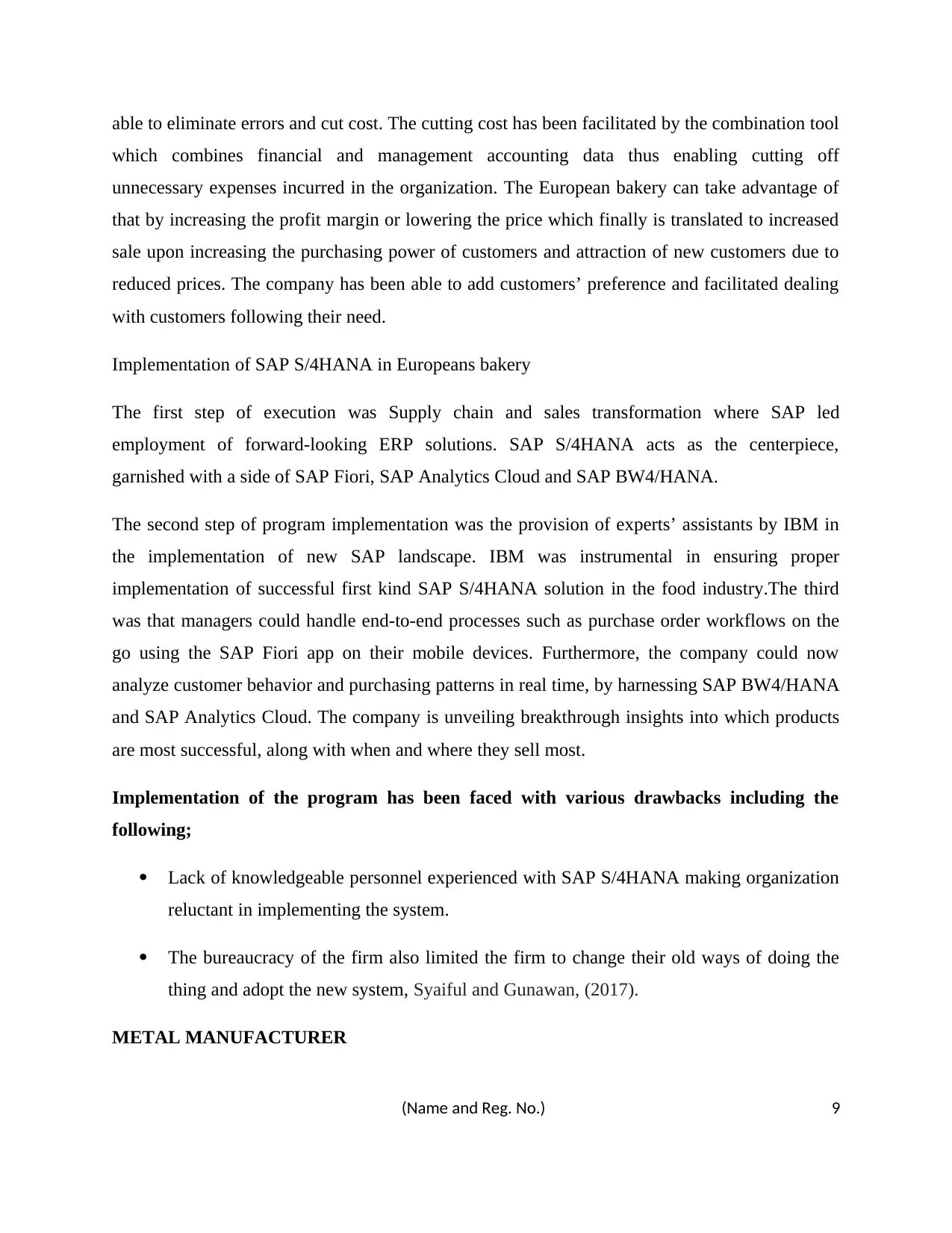
able to eliminate errors and cut cost. The cutting cost has been facilitated by the combination tool
which combines financial and management accounting data thus enabling cutting off
unnecessary expenses incurred in the organization. The European bakery can take advantage of
that by increasing the profit margin or lowering the price which finally is translated to increased
sale upon increasing the purchasing power of customers and attraction of new customers due to
reduced prices. The company has been able to add customers’ preference and facilitated dealing
with customers following their need.
Implementation of SAP S/4HANA in Europeans bakery
The first step of execution was Supply chain and sales transformation where SAP led
employment of forward-looking ERP solutions. SAP S/4HANA acts as the centerpiece,
garnished with a side of SAP Fiori, SAP Analytics Cloud and SAP BW4/HANA.
The second step of program implementation was the provision of experts’ assistants by IBM in
the implementation of new SAP landscape. IBM was instrumental in ensuring proper
implementation of successful first kind SAP S/4HANA solution in the food industry.The third
was that managers could handle end-to-end processes such as purchase order workflows on the
go using the SAP Fiori app on their mobile devices. Furthermore, the company could now
analyze customer behavior and purchasing patterns in real time, by harnessing SAP BW4/HANA
and SAP Analytics Cloud. The company is unveiling breakthrough insights into which products
are most successful, along with when and where they sell most.
Implementation of the program has been faced with various drawbacks including the
following;
Lack of knowledgeable personnel experienced with SAP S/4HANA making organization
reluctant in implementing the system.
The bureaucracy of the firm also limited the firm to change their old ways of doing the
thing and adopt the new system, Syaiful and Gunawan, (2017).
METAL MANUFACTURER
(Name and Reg. No.) 9
which combines financial and management accounting data thus enabling cutting off
unnecessary expenses incurred in the organization. The European bakery can take advantage of
that by increasing the profit margin or lowering the price which finally is translated to increased
sale upon increasing the purchasing power of customers and attraction of new customers due to
reduced prices. The company has been able to add customers’ preference and facilitated dealing
with customers following their need.
Implementation of SAP S/4HANA in Europeans bakery
The first step of execution was Supply chain and sales transformation where SAP led
employment of forward-looking ERP solutions. SAP S/4HANA acts as the centerpiece,
garnished with a side of SAP Fiori, SAP Analytics Cloud and SAP BW4/HANA.
The second step of program implementation was the provision of experts’ assistants by IBM in
the implementation of new SAP landscape. IBM was instrumental in ensuring proper
implementation of successful first kind SAP S/4HANA solution in the food industry.The third
was that managers could handle end-to-end processes such as purchase order workflows on the
go using the SAP Fiori app on their mobile devices. Furthermore, the company could now
analyze customer behavior and purchasing patterns in real time, by harnessing SAP BW4/HANA
and SAP Analytics Cloud. The company is unveiling breakthrough insights into which products
are most successful, along with when and where they sell most.
Implementation of the program has been faced with various drawbacks including the
following;
Lack of knowledgeable personnel experienced with SAP S/4HANA making organization
reluctant in implementing the system.
The bureaucracy of the firm also limited the firm to change their old ways of doing the
thing and adopt the new system, Syaiful and Gunawan, (2017).
METAL MANUFACTURER
(Name and Reg. No.) 9
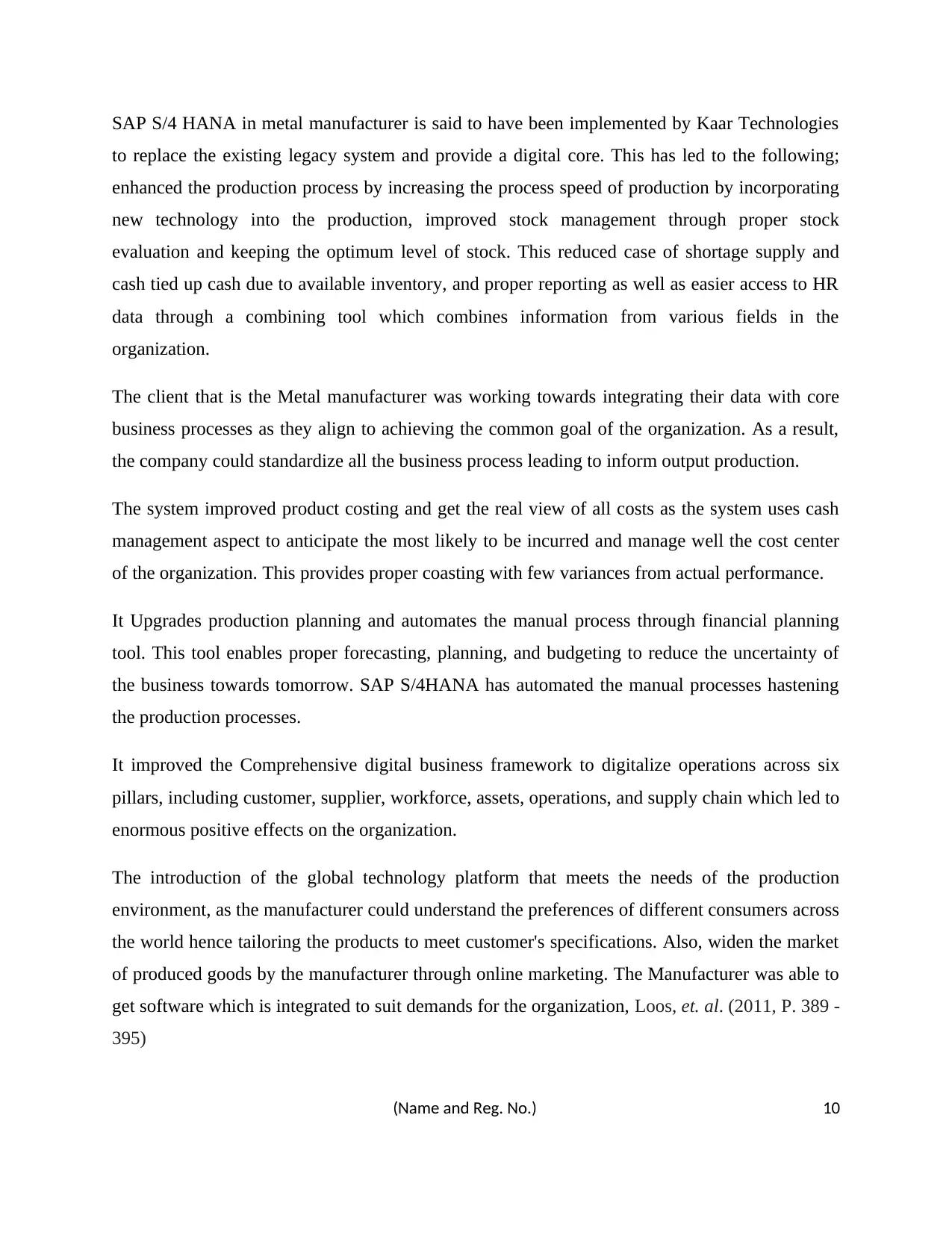
SAP S/4 HANA in metal manufacturer is said to have been implemented by Kaar Technologies
to replace the existing legacy system and provide a digital core. This has led to the following;
enhanced the production process by increasing the process speed of production by incorporating
new technology into the production, improved stock management through proper stock
evaluation and keeping the optimum level of stock. This reduced case of shortage supply and
cash tied up cash due to available inventory, and proper reporting as well as easier access to HR
data through a combining tool which combines information from various fields in the
organization.
The client that is the Metal manufacturer was working towards integrating their data with core
business processes as they align to achieving the common goal of the organization. As a result,
the company could standardize all the business process leading to inform output production.
The system improved product costing and get the real view of all costs as the system uses cash
management aspect to anticipate the most likely to be incurred and manage well the cost center
of the organization. This provides proper coasting with few variances from actual performance.
It Upgrades production planning and automates the manual process through financial planning
tool. This tool enables proper forecasting, planning, and budgeting to reduce the uncertainty of
the business towards tomorrow. SAP S/4HANA has automated the manual processes hastening
the production processes.
It improved the Comprehensive digital business framework to digitalize operations across six
pillars, including customer, supplier, workforce, assets, operations, and supply chain which led to
enormous positive effects on the organization.
The introduction of the global technology platform that meets the needs of the production
environment, as the manufacturer could understand the preferences of different consumers across
the world hence tailoring the products to meet customer's specifications. Also, widen the market
of produced goods by the manufacturer through online marketing. The Manufacturer was able to
get software which is integrated to suit demands for the organization, Loos, et. al. (2011, P. 389 -
395)
(Name and Reg. No.) 10
to replace the existing legacy system and provide a digital core. This has led to the following;
enhanced the production process by increasing the process speed of production by incorporating
new technology into the production, improved stock management through proper stock
evaluation and keeping the optimum level of stock. This reduced case of shortage supply and
cash tied up cash due to available inventory, and proper reporting as well as easier access to HR
data through a combining tool which combines information from various fields in the
organization.
The client that is the Metal manufacturer was working towards integrating their data with core
business processes as they align to achieving the common goal of the organization. As a result,
the company could standardize all the business process leading to inform output production.
The system improved product costing and get the real view of all costs as the system uses cash
management aspect to anticipate the most likely to be incurred and manage well the cost center
of the organization. This provides proper coasting with few variances from actual performance.
It Upgrades production planning and automates the manual process through financial planning
tool. This tool enables proper forecasting, planning, and budgeting to reduce the uncertainty of
the business towards tomorrow. SAP S/4HANA has automated the manual processes hastening
the production processes.
It improved the Comprehensive digital business framework to digitalize operations across six
pillars, including customer, supplier, workforce, assets, operations, and supply chain which led to
enormous positive effects on the organization.
The introduction of the global technology platform that meets the needs of the production
environment, as the manufacturer could understand the preferences of different consumers across
the world hence tailoring the products to meet customer's specifications. Also, widen the market
of produced goods by the manufacturer through online marketing. The Manufacturer was able to
get software which is integrated to suit demands for the organization, Loos, et. al. (2011, P. 389 -
395)
(Name and Reg. No.) 10
Secure Best Marks with AI Grader
Need help grading? Try our AI Grader for instant feedback on your assignments.
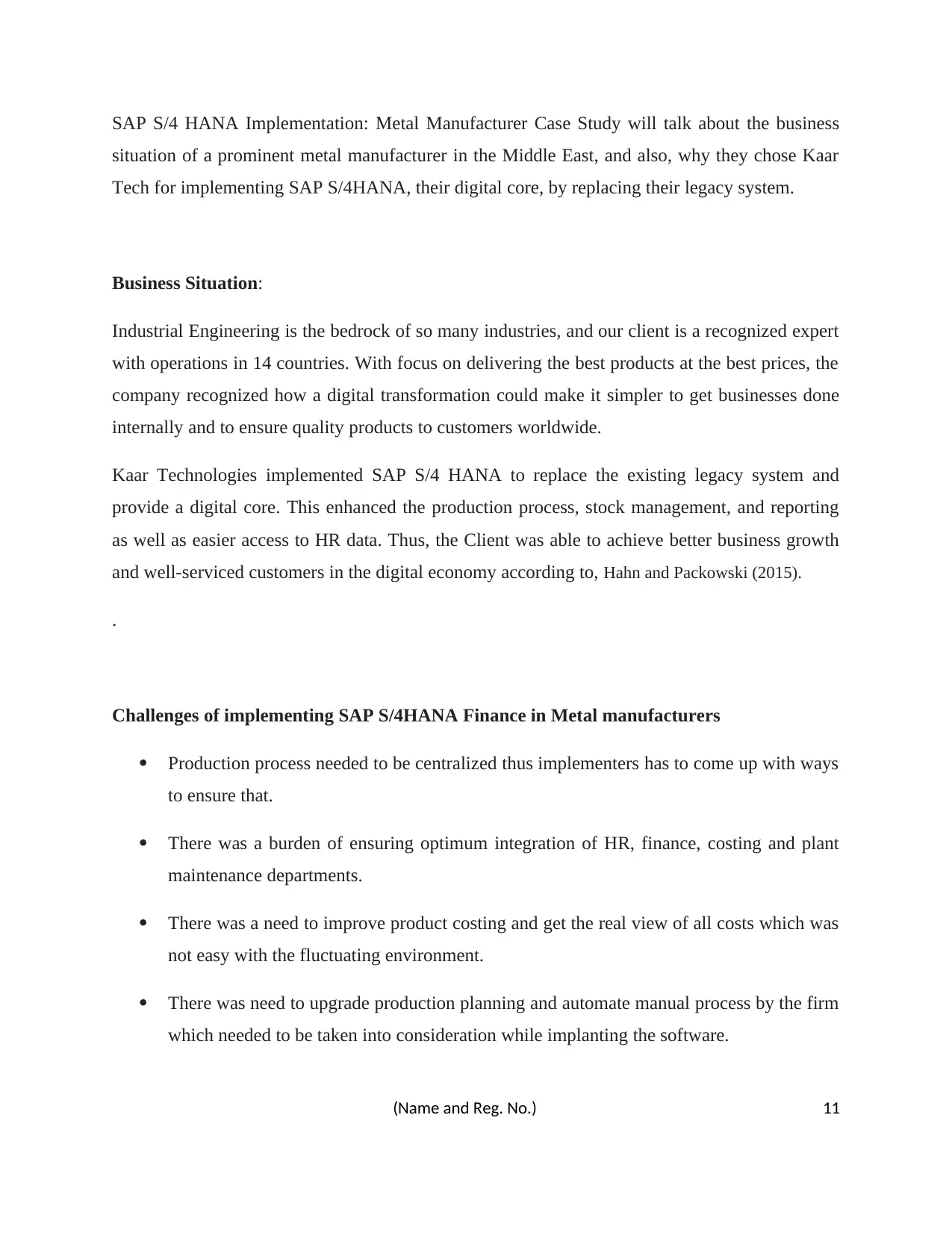
SAP S/4 HANA Implementation: Metal Manufacturer Case Study will talk about the business
situation of a prominent metal manufacturer in the Middle East, and also, why they chose Kaar
Tech for implementing SAP S/4HANA, their digital core, by replacing their legacy system.
Business Situation:
Industrial Engineering is the bedrock of so many industries, and our client is a recognized expert
with operations in 14 countries. With focus on delivering the best products at the best prices, the
company recognized how a digital transformation could make it simpler to get businesses done
internally and to ensure quality products to customers worldwide.
Kaar Technologies implemented SAP S/4 HANA to replace the existing legacy system and
provide a digital core. This enhanced the production process, stock management, and reporting
as well as easier access to HR data. Thus, the Client was able to achieve better business growth
and well-serviced customers in the digital economy according to, Hahn and Packowski (2015).
.
Challenges of implementing SAP S/4HANA Finance in Metal manufacturers
Production process needed to be centralized thus implementers has to come up with ways
to ensure that.
There was a burden of ensuring optimum integration of HR, finance, costing and plant
maintenance departments.
There was a need to improve product costing and get the real view of all costs which was
not easy with the fluctuating environment.
There was need to upgrade production planning and automate manual process by the firm
which needed to be taken into consideration while implanting the software.
(Name and Reg. No.) 11
situation of a prominent metal manufacturer in the Middle East, and also, why they chose Kaar
Tech for implementing SAP S/4HANA, their digital core, by replacing their legacy system.
Business Situation:
Industrial Engineering is the bedrock of so many industries, and our client is a recognized expert
with operations in 14 countries. With focus on delivering the best products at the best prices, the
company recognized how a digital transformation could make it simpler to get businesses done
internally and to ensure quality products to customers worldwide.
Kaar Technologies implemented SAP S/4 HANA to replace the existing legacy system and
provide a digital core. This enhanced the production process, stock management, and reporting
as well as easier access to HR data. Thus, the Client was able to achieve better business growth
and well-serviced customers in the digital economy according to, Hahn and Packowski (2015).
.
Challenges of implementing SAP S/4HANA Finance in Metal manufacturers
Production process needed to be centralized thus implementers has to come up with ways
to ensure that.
There was a burden of ensuring optimum integration of HR, finance, costing and plant
maintenance departments.
There was a need to improve product costing and get the real view of all costs which was
not easy with the fluctuating environment.
There was need to upgrade production planning and automate manual process by the firm
which needed to be taken into consideration while implanting the software.
(Name and Reg. No.) 11
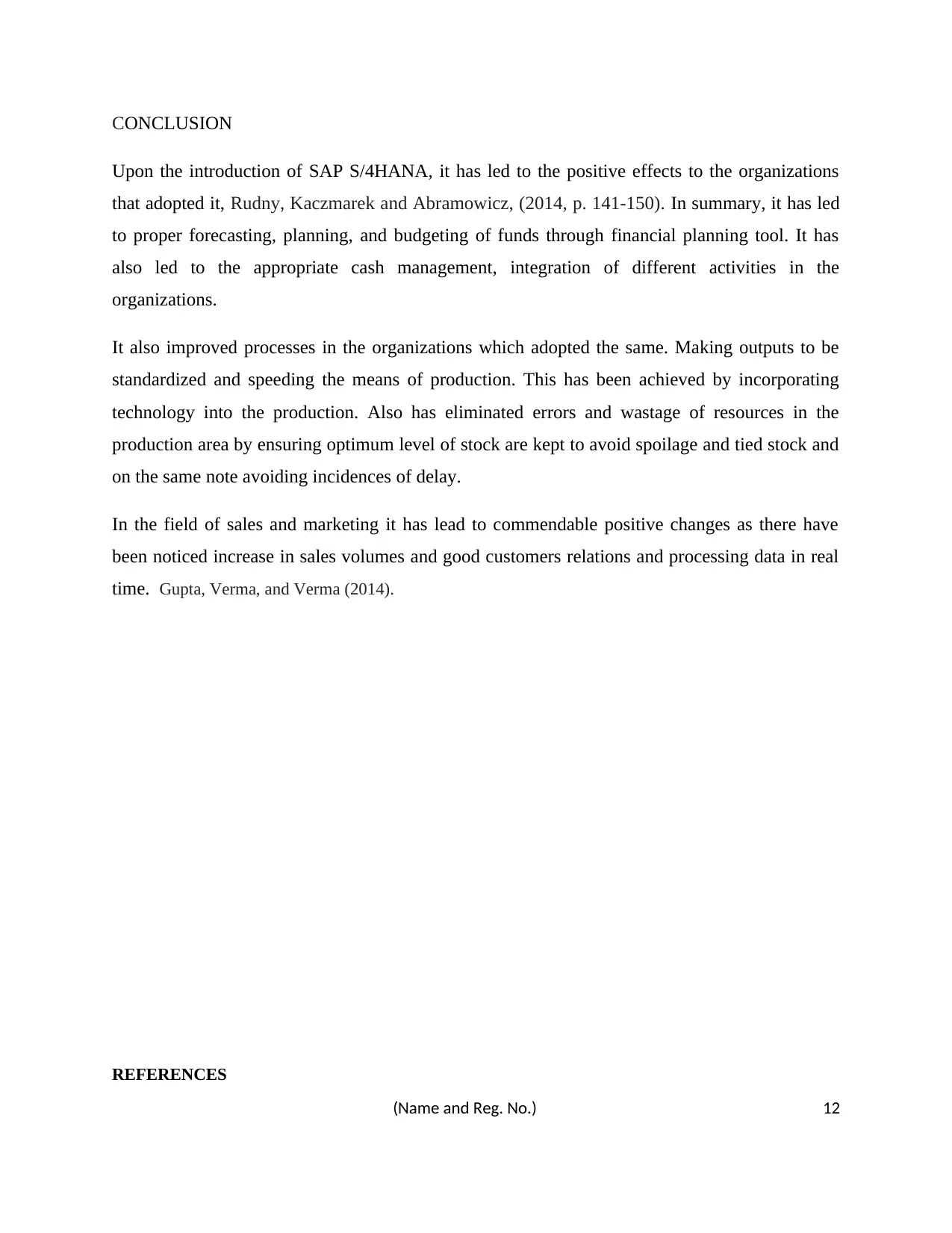
CONCLUSION
Upon the introduction of SAP S/4HANA, it has led to the positive effects to the organizations
that adopted it, Rudny, Kaczmarek and Abramowicz, (2014, p. 141-150). In summary, it has led
to proper forecasting, planning, and budgeting of funds through financial planning tool. It has
also led to the appropriate cash management, integration of different activities in the
organizations.
It also improved processes in the organizations which adopted the same. Making outputs to be
standardized and speeding the means of production. This has been achieved by incorporating
technology into the production. Also has eliminated errors and wastage of resources in the
production area by ensuring optimum level of stock are kept to avoid spoilage and tied stock and
on the same note avoiding incidences of delay.
In the field of sales and marketing it has lead to commendable positive changes as there have
been noticed increase in sales volumes and good customers relations and processing data in real
time. Gupta, Verma, and Verma (2014).
REFERENCES
(Name and Reg. No.) 12
Upon the introduction of SAP S/4HANA, it has led to the positive effects to the organizations
that adopted it, Rudny, Kaczmarek and Abramowicz, (2014, p. 141-150). In summary, it has led
to proper forecasting, planning, and budgeting of funds through financial planning tool. It has
also led to the appropriate cash management, integration of different activities in the
organizations.
It also improved processes in the organizations which adopted the same. Making outputs to be
standardized and speeding the means of production. This has been achieved by incorporating
technology into the production. Also has eliminated errors and wastage of resources in the
production area by ensuring optimum level of stock are kept to avoid spoilage and tied stock and
on the same note avoiding incidences of delay.
In the field of sales and marketing it has lead to commendable positive changes as there have
been noticed increase in sales volumes and good customers relations and processing data in real
time. Gupta, Verma, and Verma (2014).
REFERENCES
(Name and Reg. No.) 12
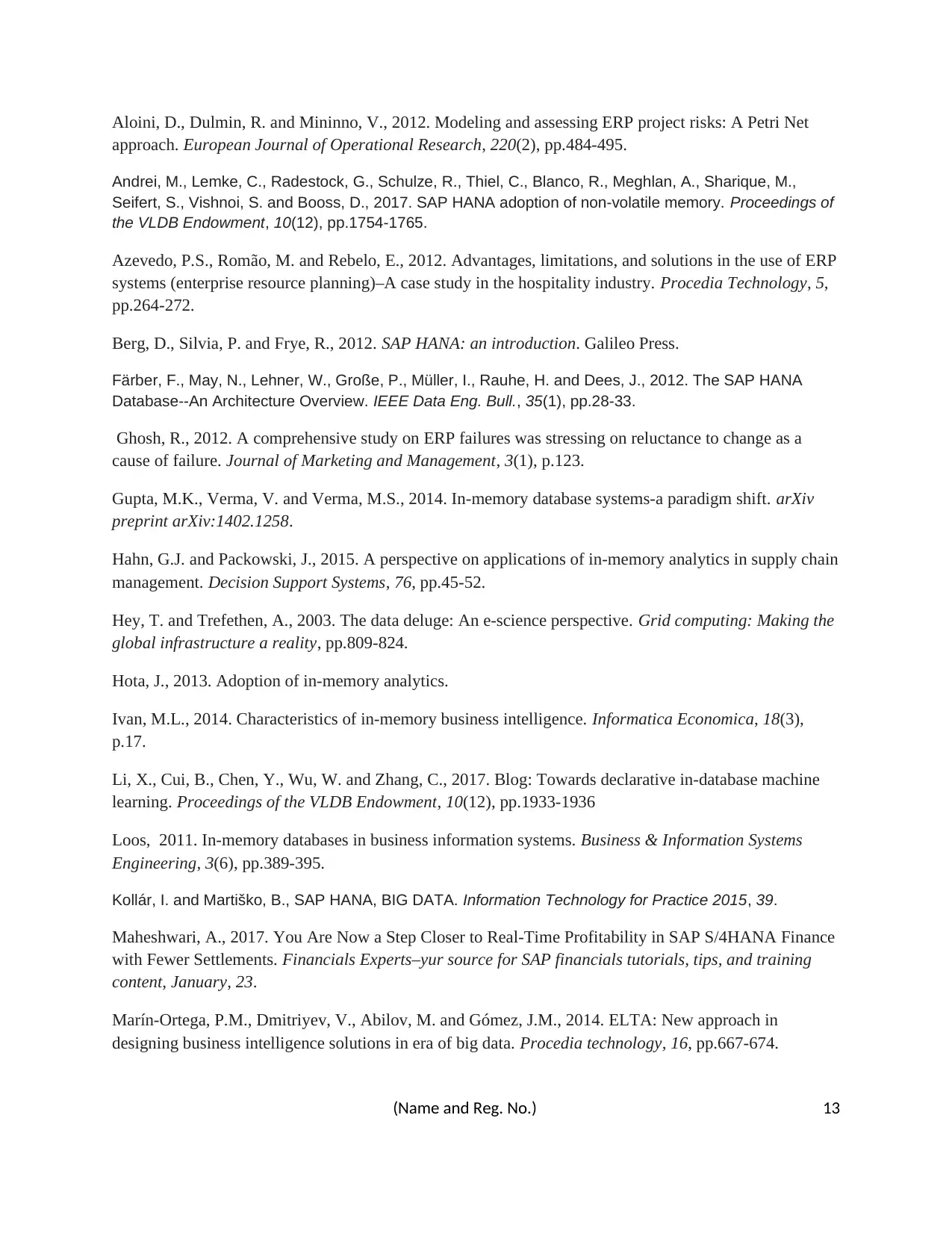
Aloini, D., Dulmin, R. and Mininno, V., 2012. Modeling and assessing ERP project risks: A Petri Net
approach. European Journal of Operational Research, 220(2), pp.484-495.
Andrei, M., Lemke, C., Radestock, G., Schulze, R., Thiel, C., Blanco, R., Meghlan, A., Sharique, M.,
Seifert, S., Vishnoi, S. and Booss, D., 2017. SAP HANA adoption of non-volatile memory. Proceedings of
the VLDB Endowment, 10(12), pp.1754-1765.
Azevedo, P.S., Romão, M. and Rebelo, E., 2012. Advantages, limitations, and solutions in the use of ERP
systems (enterprise resource planning)–A case study in the hospitality industry. Procedia Technology, 5,
pp.264-272.
Berg, D., Silvia, P. and Frye, R., 2012. SAP HANA: an introduction. Galileo Press.
Färber, F., May, N., Lehner, W., Große, P., Müller, I., Rauhe, H. and Dees, J., 2012. The SAP HANA
Database--An Architecture Overview. IEEE Data Eng. Bull., 35(1), pp.28-33.
Ghosh, R., 2012. A comprehensive study on ERP failures was stressing on reluctance to change as a
cause of failure. Journal of Marketing and Management, 3(1), p.123.
Gupta, M.K., Verma, V. and Verma, M.S., 2014. In-memory database systems-a paradigm shift. arXiv
preprint arXiv:1402.1258.
Hahn, G.J. and Packowski, J., 2015. A perspective on applications of in-memory analytics in supply chain
management. Decision Support Systems, 76, pp.45-52.
Hey, T. and Trefethen, A., 2003. The data deluge: An e‐science perspective. Grid computing: Making the
global infrastructure a reality, pp.809-824.
Hota, J., 2013. Adoption of in-memory analytics.
Ivan, M.L., 2014. Characteristics of in-memory business intelligence. Informatica Economica, 18(3),
p.17.
Li, X., Cui, B., Chen, Y., Wu, W. and Zhang, C., 2017. Blog: Towards declarative in-database machine
learning. Proceedings of the VLDB Endowment, 10(12), pp.1933-1936
Loos, 2011. In-memory databases in business information systems. Business & Information Systems
Engineering, 3(6), pp.389-395.
Kollár, I. and Martiško, B., SAP HANA, BIG DATA. Information Technology for Practice 2015, 39.
Maheshwari, A., 2017. You Are Now a Step Closer to Real-Time Profitability in SAP S/4HANA Finance
with Fewer Settlements. Financials Experts–yur source for SAP financials tutorials, tips, and training
content, January, 23.
Marín-Ortega, P.M., Dmitriyev, V., Abilov, M. and Gómez, J.M., 2014. ELTA: New approach in
designing business intelligence solutions in era of big data. Procedia technology, 16, pp.667-674.
(Name and Reg. No.) 13
approach. European Journal of Operational Research, 220(2), pp.484-495.
Andrei, M., Lemke, C., Radestock, G., Schulze, R., Thiel, C., Blanco, R., Meghlan, A., Sharique, M.,
Seifert, S., Vishnoi, S. and Booss, D., 2017. SAP HANA adoption of non-volatile memory. Proceedings of
the VLDB Endowment, 10(12), pp.1754-1765.
Azevedo, P.S., Romão, M. and Rebelo, E., 2012. Advantages, limitations, and solutions in the use of ERP
systems (enterprise resource planning)–A case study in the hospitality industry. Procedia Technology, 5,
pp.264-272.
Berg, D., Silvia, P. and Frye, R., 2012. SAP HANA: an introduction. Galileo Press.
Färber, F., May, N., Lehner, W., Große, P., Müller, I., Rauhe, H. and Dees, J., 2012. The SAP HANA
Database--An Architecture Overview. IEEE Data Eng. Bull., 35(1), pp.28-33.
Ghosh, R., 2012. A comprehensive study on ERP failures was stressing on reluctance to change as a
cause of failure. Journal of Marketing and Management, 3(1), p.123.
Gupta, M.K., Verma, V. and Verma, M.S., 2014. In-memory database systems-a paradigm shift. arXiv
preprint arXiv:1402.1258.
Hahn, G.J. and Packowski, J., 2015. A perspective on applications of in-memory analytics in supply chain
management. Decision Support Systems, 76, pp.45-52.
Hey, T. and Trefethen, A., 2003. The data deluge: An e‐science perspective. Grid computing: Making the
global infrastructure a reality, pp.809-824.
Hota, J., 2013. Adoption of in-memory analytics.
Ivan, M.L., 2014. Characteristics of in-memory business intelligence. Informatica Economica, 18(3),
p.17.
Li, X., Cui, B., Chen, Y., Wu, W. and Zhang, C., 2017. Blog: Towards declarative in-database machine
learning. Proceedings of the VLDB Endowment, 10(12), pp.1933-1936
Loos, 2011. In-memory databases in business information systems. Business & Information Systems
Engineering, 3(6), pp.389-395.
Kollár, I. and Martiško, B., SAP HANA, BIG DATA. Information Technology for Practice 2015, 39.
Maheshwari, A., 2017. You Are Now a Step Closer to Real-Time Profitability in SAP S/4HANA Finance
with Fewer Settlements. Financials Experts–yur source for SAP financials tutorials, tips, and training
content, January, 23.
Marín-Ortega, P.M., Dmitriyev, V., Abilov, M. and Gómez, J.M., 2014. ELTA: New approach in
designing business intelligence solutions in era of big data. Procedia technology, 16, pp.667-674.
(Name and Reg. No.) 13
Paraphrase This Document
Need a fresh take? Get an instant paraphrase of this document with our AI Paraphraser
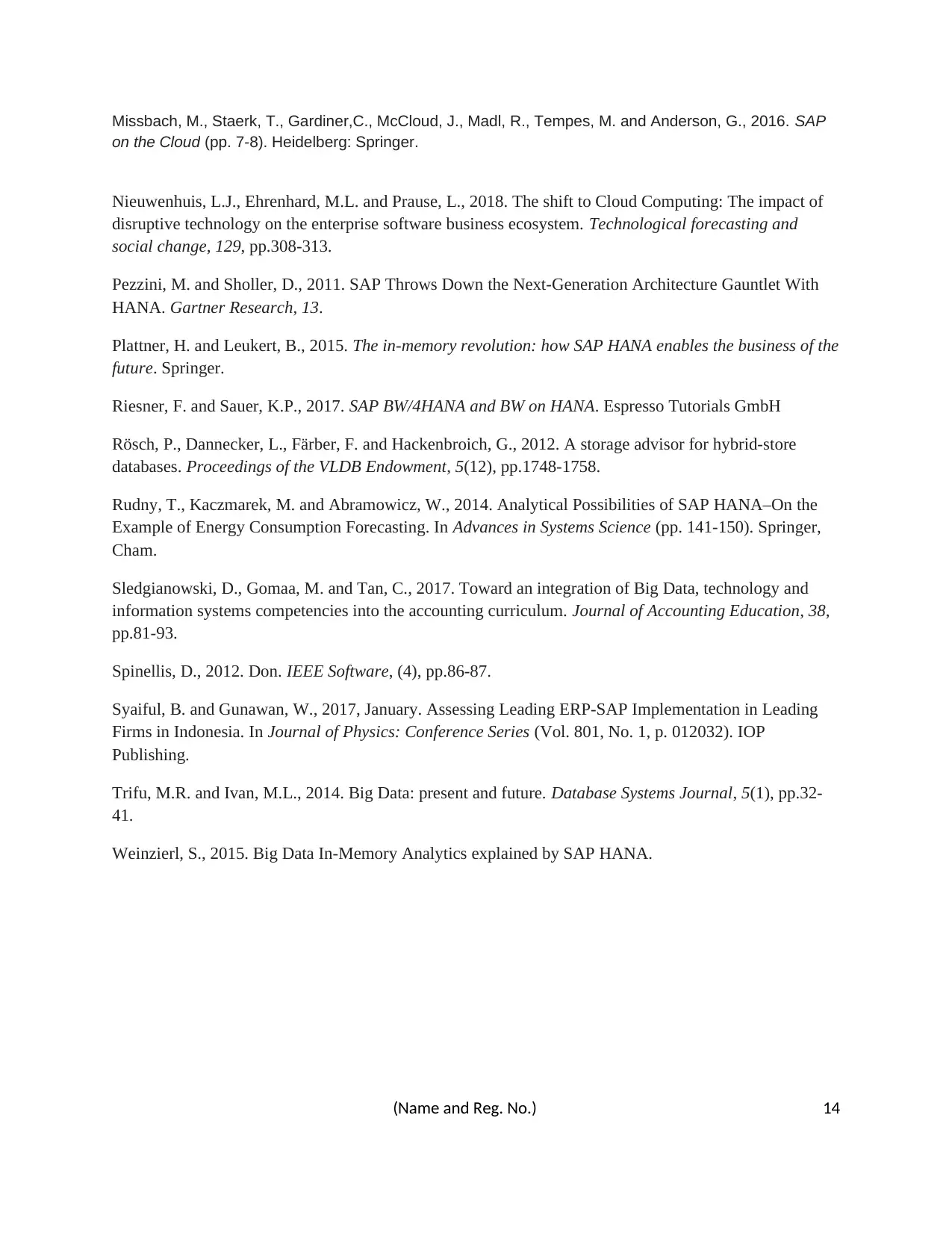
Missbach, M., Staerk, T., Gardiner,C., McCloud, J., Madl, R., Tempes, M. and Anderson, G., 2016. SAP
on the Cloud (pp. 7-8). Heidelberg: Springer.
Nieuwenhuis, L.J., Ehrenhard, M.L. and Prause, L., 2018. The shift to Cloud Computing: The impact of
disruptive technology on the enterprise software business ecosystem. Technological forecasting and
social change, 129, pp.308-313.
Pezzini, M. and Sholler, D., 2011. SAP Throws Down the Next-Generation Architecture Gauntlet With
HANA. Gartner Research, 13.
Plattner, H. and Leukert, B., 2015. The in-memory revolution: how SAP HANA enables the business of the
future. Springer.
Riesner, F. and Sauer, K.P., 2017. SAP BW/4HANA and BW on HANA. Espresso Tutorials GmbH
Rösch, P., Dannecker, L., Färber, F. and Hackenbroich, G., 2012. A storage advisor for hybrid-store
databases. Proceedings of the VLDB Endowment, 5(12), pp.1748-1758.
Rudny, T., Kaczmarek, M. and Abramowicz, W., 2014. Analytical Possibilities of SAP HANA–On the
Example of Energy Consumption Forecasting. In Advances in Systems Science (pp. 141-150). Springer,
Cham.
Sledgianowski, D., Gomaa, M. and Tan, C., 2017. Toward an integration of Big Data, technology and
information systems competencies into the accounting curriculum. Journal of Accounting Education, 38,
pp.81-93.
Spinellis, D., 2012. Don. IEEE Software, (4), pp.86-87.
Syaiful, B. and Gunawan, W., 2017, January. Assessing Leading ERP-SAP Implementation in Leading
Firms in Indonesia. In Journal of Physics: Conference Series (Vol. 801, No. 1, p. 012032). IOP
Publishing.
Trifu, M.R. and Ivan, M.L., 2014. Big Data: present and future. Database Systems Journal, 5(1), pp.32-
41.
Weinzierl, S., 2015. Big Data In-Memory Analytics explained by SAP HANA.
(Name and Reg. No.) 14
on the Cloud (pp. 7-8). Heidelberg: Springer.
Nieuwenhuis, L.J., Ehrenhard, M.L. and Prause, L., 2018. The shift to Cloud Computing: The impact of
disruptive technology on the enterprise software business ecosystem. Technological forecasting and
social change, 129, pp.308-313.
Pezzini, M. and Sholler, D., 2011. SAP Throws Down the Next-Generation Architecture Gauntlet With
HANA. Gartner Research, 13.
Plattner, H. and Leukert, B., 2015. The in-memory revolution: how SAP HANA enables the business of the
future. Springer.
Riesner, F. and Sauer, K.P., 2017. SAP BW/4HANA and BW on HANA. Espresso Tutorials GmbH
Rösch, P., Dannecker, L., Färber, F. and Hackenbroich, G., 2012. A storage advisor for hybrid-store
databases. Proceedings of the VLDB Endowment, 5(12), pp.1748-1758.
Rudny, T., Kaczmarek, M. and Abramowicz, W., 2014. Analytical Possibilities of SAP HANA–On the
Example of Energy Consumption Forecasting. In Advances in Systems Science (pp. 141-150). Springer,
Cham.
Sledgianowski, D., Gomaa, M. and Tan, C., 2017. Toward an integration of Big Data, technology and
information systems competencies into the accounting curriculum. Journal of Accounting Education, 38,
pp.81-93.
Spinellis, D., 2012. Don. IEEE Software, (4), pp.86-87.
Syaiful, B. and Gunawan, W., 2017, January. Assessing Leading ERP-SAP Implementation in Leading
Firms in Indonesia. In Journal of Physics: Conference Series (Vol. 801, No. 1, p. 012032). IOP
Publishing.
Trifu, M.R. and Ivan, M.L., 2014. Big Data: present and future. Database Systems Journal, 5(1), pp.32-
41.
Weinzierl, S., 2015. Big Data In-Memory Analytics explained by SAP HANA.
(Name and Reg. No.) 14
1 out of 14
Related Documents
Your All-in-One AI-Powered Toolkit for Academic Success.
+13062052269
info@desklib.com
Available 24*7 on WhatsApp / Email
![[object Object]](/_next/static/media/star-bottom.7253800d.svg)
Unlock your academic potential
© 2024 | Zucol Services PVT LTD | All rights reserved.




